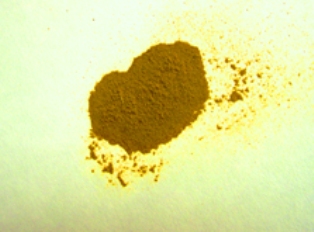Sparton Resources announced that it had successfully produced a small quantity of yellowcake (U3O8) from fly ash from a Chinese coal-fired power plant.
 The uranium extraction test work is being conducted by Sparton's processing engineering consulting firm Lyntek Inc of Denver, Colorado, USA. The test to produce yellowcake used 6.1 kg of mixed fly ash produced at the Xiaolongtang power plant. The ash averaged some 0.4 pounds of U308 per tonne of ash (160 parts per million uranium).
The uranium extraction test work is being conducted by Sparton's processing engineering consulting firm Lyntek Inc of Denver, Colorado, USA. The test to produce yellowcake used 6.1 kg of mixed fly ash produced at the Xiaolongtang power plant. The ash averaged some 0.4 pounds of U308 per tonne of ash (160 parts per million uranium).
Leaching was done with sulphuric acid and the yellowcake was produced by passing the filtered leach solution through a standard ion exchange resin, stripping the resin and precipitating the uranium compound. This process is essentially similar to the uranium extraction and yellowcake production methods used by primary uranium ore processing plants or in-situ leach (ISL) operations using an acidic leaching solution.
New test work currently in progress will focus on refining the leaching, filtering and ion exchange processes. The leach solutions contain significant amounts of gypsum and iron oxide which require removal by filtering prior to passing them through the ion exchange system. The next tests will evaluate uranium extraction from ash from the large waste pile at Xiaolongtang. A 20 kg representative sample taken from drill holes used to test the waste pile will be used for this work.
Xiaolongtang coal-ash stockpile
Meanwhile, Sparton said that a drilling program on the fly ash waste pile at Xiaolongtang was completed in September and the results indicated that pile is on average some 17 metres thick and contains around 5.3 million tonnes of ash. In July, Sparton suggested that the stockpile could contain up to 10 million tonnes of coal ash. Staff at the power plant had previously estimated there were some 5 million tonnes of ash. Initial tests by Lyntek indicated that the material contains some 0.46 pounds of U308 per tonne of ash (160-180 parts per million uranium), suggesting a total of some 2085 tonnes U3O8 (1770 tU) are contained in the Xiaolongtang ash piles.
In early January 2007, Canada's Sparton announced the signing of an agreement with the Xiaolongtang Guodian Power Company for a three-phase program to test and possibly commercialize the extraction of uranium from waste coal ash at the company's thermal power stations in Yunnan province. Sparton, together with its partner ARCN - the remote sensing and research branch of state-owned China National Nuclear Corp (CNNC) - has identified Xiaolongtang and nearby power plants as a possible major supply of uraniferous coal ash.
The Xiaolongtang, Dalongtang and the Kaiyuan stations, all located within 20 km of each other, burn coal from a centrally located open pit lignite coal mine that contains anomalously high uranium content. The plants are located approximately 250 km southeast of the Yunnan provincial capital of Kunming.
Since signing the agreement with China, Sparton has also signed agreements to do similar programs in six countries in Central Europe and with South Africa.
Further information
WNA's Naturally-Occurring Radioactive Materials (NORM) information paper
WNN: Sparton: More coal ash, more uranium
WNN: WildHorse and Sparton study coal ash
WNN: CNNC looks for new sources of uranium
WNN: Project to extract uranium from coal ash





_69614.jpg)

_15447.jpg)




